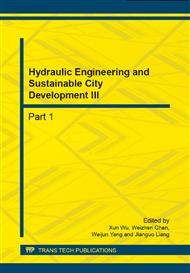[1]
R.G. Allen, L.S. Pereira, D. Raes and M. Smith, Crop evapotranspiration-Guide-lines for computing crop water requirements. In: Irrigation and Drainage Paper 56. United Nations Food and Agriculture Organization, Rome, Italy (1998).
Google Scholar
[2]
J. Doorenbos, W.O. Pruitt, Crop Water Requirements. Irrigation and Drainage Paper No. 24 (rev. ) (1977), FAO, Rome, Italy, p.144.
Google Scholar
[3]
C.W. Thornthwaite, An approach toward a rational classification of climate. Geographical Review. 38, 55-94. ( 1948).
Google Scholar
[4]
G.H. Hargreaves, Estimation of potential and crop evapotranspiration. T ASAE. 17 (4), 701-704. (1974).
Google Scholar
[5]
G.H. Hargreaves, Defining and using reference evapotranspiration. J. Irrig. Drain. E-ASCE. 120 (6), 1132-1139. (1994).
Google Scholar
[6]
C.H.B. Priestley, R.J. Taylor, On the assessment of the surface of the heat flux and evaporation using large scale parameters. Mon. Weather Rev. 100, 81-92. (1972).
DOI: 10.1175/1520-0493(1972)100<0081:otaosh>2.3.co;2
Google Scholar
[7]
H.L. Penman, Natural evaporation from open water, bare soil and grass. Proc. R. Soc. London, Ser. 193, 454-465. (1948).
Google Scholar
[8]
H.L. Penman, Vegetation and Hydrology. Common wealth Bureau of Soils, Technical Communication No. p.53. (1963).
Google Scholar
[9]
P. Droogers, R.G. Allen, Estimating reference evapotranspiration under inaccurate data conditions. Irrig. Drain. Syst. 16, 33-45. (2002).
Google Scholar
[10]
IPCC. Climate Change 2007: The Physical Science Basis, Contribution of Working Group I to the Fourth Assessment Report of the Intergovernmental Panel on Climate Change, Solomon S, Qin D, Manning M, Marquis M, Averyt K, Tignor M, Miller H, Chen Z (eds). Cambridge University Press: Cambridge. (2007).
DOI: 10.1080/01944363.2014.954464
Google Scholar


